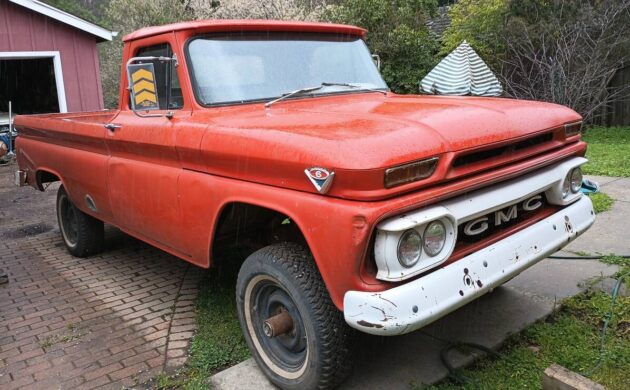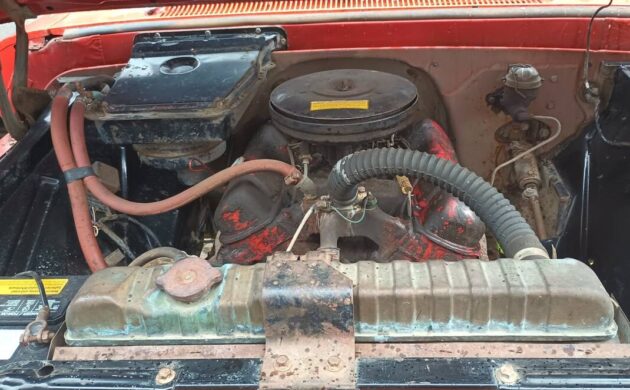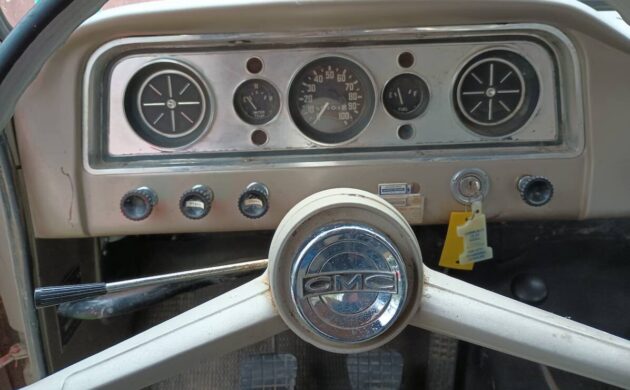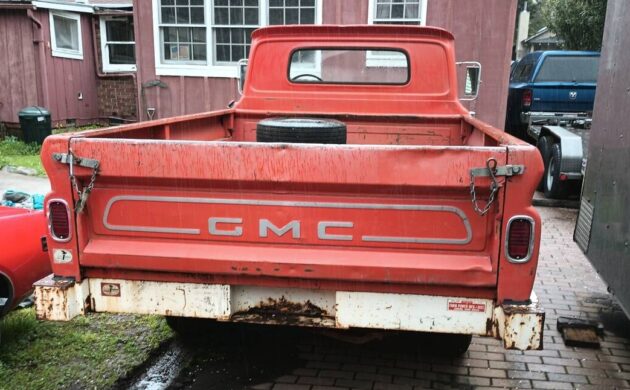After decades of service as a South Dakota farm truck, this nearly all-original 1964 GMC 4×4 pickup comes to market in running mechanical condition. The faded red original paint, never-repaired dents, and tall skinny tires complete the authentic work horse look from a time before trucks offered heated seats, Bluetooth, and menus to set trailer type and brake gain. Check out more details and pictures here on Craigslist, where a $16,000 asking price seals the deal. The classic currently resides near New Almaden, California outside San Jose. Thanks to reader Tony P. for spotting the honest work truck.
Full-size V6 pickup trucks fill driveways and garages everywhere today, but GMC struck a novel chord with its large V6 truck motors, produced from 1959 to 1974. By displacement, the series begins with this 305 cid (5.0L) V6, progressing up to 478 cid (7.8L) in larger trucks, according to Wikipedia. There was even a 702 cid (11.5 L) V12 or “Twin Six” mating two V6 blocks into one utilizing dual carburetors, intake and exhaust manifolds, and other parts shared with the 351 V6. This specimen’s big bent six still runs after some 50,000 miles, most likely occuring off-highway and in one county. Purportedly garaged each winter, the 4×4 features a four-speed manual transmission, beginning with a “granny” gear, a low-speed first gear generally used for tractor-like duties requiring high-torque, low speed power. Road driving calls for starting in second.
Crop out the steering wheel and you might think you’re looking at any industrial control panel from the ’50s or ’60s. Form follows function in the GMC’s cab, with owner-applied labels differentiating one knob from another. I can almost feel the satisfying tactile sensation of twisting the delicate flat-steel key, bringing the raspy oversized V6 to life after a few pumps of the gas pedal.
Hardware store latches secure the sturdy tailgate. Chrome barely makes an appearance on this basic truck, with the white grille and front bumper complimented by what looks like a custom-welded rear bumper, complete with corner extensions.
The GM E-Z STEP gives farm hands a leg up onto the bed from just behind the doors, facilitating a quick transition from cab to bed when accepting or securing payloads. Though not OSHA-approved, you might even ride a short distance while standing with one foot on the step. Have you heard of GMC’s big V6 truck motors?







Looks exactly like the truck I’m working on except the one I’m working on is 2wd. I’m trying to take some of the truck out of it with the addition of power disc brakes, power steering, and Sniper EFI.
Good luck on the disc brake add.
I added to a 54 3100 disc brakes with the 235 straight six.
I regret not ordering originally the manual disc brakes as it took forever to get the vacuum to work properly and maintain continuous vacuum.
This truck looks like a fun project to finish.
Good luck 🍀
Those tailgate latches were factory. Once closed, you would insert the hook up though the bottom not through the top as shown in the passenger side latch. By going up through the bottom, this insured that the hook would not “bounce out” and cause the tailgate to open.
I have heard of these trucks, these engines, my whole life.
The suburban city I grew up in, favored GMC trucks for its DPW. In that era, they had a dozen pickups, fleetside and stepside; they had flatbed one-ton stake trucks. They had a 2-1/2 ton trash packer.
All were gas and all proudly wore the GMC V-6 badge on them. I was an elementary school kid, and my old man was shopping for a utility car for a long-term project (got a Kaiser-Jeep Wagoneer) so I was aware of sixes and V-8s. Never had I heard of a V-6 – then; although I noticed that some cars at the Jeep dealership we were in, had V-6 emblems. Hmmm.
Later on, in Popular Science Monthly, Smokey Yunick ran a car-clinic readers-question feature. One reader had bought a used GMC with a V-6, and the writer wanted to replace the “oddball” engine. Smokey blew up, full of defense of that engine as one of the best made by GM. Said a Chevrolet V8 would go in, but it would be a poor replacement.
Times change. Those were massive, over-engineered 60-degree V-6s; and by the 1970s, GM decided that quality level was a waste on a consumer product. Out it went. Instead, came a variety of light-duty V-6s, first for compacts; then – like the THC200 transmission – snuck into full-size cars; and now, the default standard large engine.
Nor do you see trucks built like this. This was in the day when GMC meant boots-on-the-ground. Chrome was for Chevrolet variants.
The opposite, again, of what was. Nice time machine, this one.
I had a 63 with a 305 V6, painted black with a brush. Great truck. Not fast but would go anywhere. Ex ran a red light, totaled a mini van and drove the truck home with almost no damage.
Was the engine painted plaid?
Not the whole engine, just the valve covers got the plaid treatment.
Here are the plaid valve covers on a V-12.
https://youtu.be/xvTdHRkRnAM
First time I saw one of these was at a scrap yard when I was 16.I saw the v6 emblem and I was like what is this?.Opened the hood and sure enough it was v6! This is a cool truck at 15 k I think the price is fair.Glwts.
I remember that V~6 motor in a pickup and a couple 2 to 2 and a half ton farm trucks out around where I grew up. From what I can remember that V-6 motor wasn’t a big hit with the farmers that owned them. I know that V-6 didn’t sound as good as the V-8 motors did.
“There was even a 702 cid (11.5 L) V12 or “Twin Six” mating two V6 blocks into one.”
You’re probably aware of this, but many aren’t. The V-12 block was a unique casting, not two V-6 blocks welded together. The use of four V-6 cylinder heads leads people to believe the V-12 is welded or bolted together from two V-6s, but that’s not the case.
Thank you CCFisher. I have updated the article to be more accurate. I meant “conceptually,” but I did not say that. :) Indeed, the V12 has its own block and interchanged some parts with the 351 V6. Corrections are always appreciated. Happy motoring!
I will add some, if I don’t ruffle too many feathers in doing so,,, the “Thunder V-12” was a half baked attempt to satisfy truck owners that hadn’t made the jump to diesel. It was rated at 270 hp at a lazy 2400 rpms. Technically, it did have it’s own block, but used many of the V6 parts, and was still coined the “Twin Six”. The downsides were many. Diesels put out more hp on cheaper fuel, got better mileage( the V-12 got 2-3 mpg) and the V12 weighed almost 1500 pounds. It had a massive belt driven water pump, as overheating was an issue. Fact is, all the “accessories” were belt driven, taking up valuable hp. The 637 V8 replaced the V-12 in 1966. There is a company dedicated to the rebirth of the V-12. Why, I’m not sure. BTW, I read, the “plaid” valve covers indicate a rebuilt motor. GM had so many problems, they issued replacement motors with plaid valve covers to show the ones replaced.
interesting about the plaid covers I never knew that. I only saw them once on a early 60’s chevy pickup with a w head v-8 in a junkyard about 40 years ago as a teen.
409 with 2 cylinder’s copped off.
That assumption is incorrect, Ron. Other than a similar valve cover appearance, the GMC V6 shares nothing with the 409. Both the Chevrolet “W” engines and GMC V6 and it’s variants were developed at a time when GM’s divisions were still substantially autonomous and were complete engineering, manufacturing, and marketing entities, not just marketing organizations peddling “corporate” products.
Both engines did have one thing in common and that was that they both were used in heavy duty trucks built be General Motors in the early to mid 60s.
One major difference was the V6 had its spark plugs on the inner sides of the cylinder heads by the intake manifolds.
And the V6 had a 60 degree block. The 409 was a 90 degree.
Fifty years ago I was working at a full serve gas station. A guy pulled in driving an early ’60s Chevrolet 1/2 ton pickup. When I went to check the oil I didn’t recognize the engine. It was definitely not a small block. I thought it was a GMC V6. The driver told me it was a 409, and holy moly. That was the only 409 I’d ever seen in daily usage.
In the early 60s the only trucks Chevrolet put the 409 in was the heavy duty 80 series, the top of the line, but it is quite conceivable one of those heavy truck 409s could have found its way into a half ton pickup. More likely the 409 was a passenger car transplant
This is a beautiful rig, from the time when “trucks” were TRUCKS. That GMC V-6 was a true truck engine, designed for full-size (medium to heavy duty) trucks, even the pickup version. These weren’t neck-snappers but boy could they pull. I used to drive a 1965 GMC 60 passenger school bus that has a 305. Although it wouldn’t win any stop light drags, it moved its load along adequately with not as bad gas mileage as you might think, about 8 mpg on the average which wasnt bad for a big old gas bus. The main difference between the big truck or bus version of the 305 was the 8-quart oil pan and large canister oil filter on the heavier C version as differentiated from the lighter duty E version of the 305. But the same incredibly strong guts. Together with International Harvester, the GMC of that era occupied the true truck niche of the pickup market.
My heart is taken by the granny four speed… I so miss my 52 GMC.
I learned to drive a standard on a 1969 GMC 1500 with the 305 V-6 and three on the tree. Ours was cold blooded in the winter (Buffalo NY), losing all heat to the cab after idling a few minutes; new thermostat didn’t matter. All the city school buses ran GMC V-6s.
I just recently bought one of these beasts!
The V6 is long gone but was replaced with a small journal 327 with camel hump heads..runs great. I thought it was appropriate to put a true American hero’s emblem on it too also! God bless Chris Kyle…with a few more upgrades it will be on the road or for sale shortly!
If interested give me a text for details!
(765)-977-8747
My father worked in a foundry casting those engines from 62-66, So I have indeed heard of them.
That was when trucks were trucks. That 230 six was a great truck engine, too. I had one in a GMC step van, and we had one at work in a 1965 Chevrolet C-50, hauling drill rigs. A bit logy, but got the job done. We replaced it with a 72 Chevy C-60, with the 427, hauling the same drill rigs, so shows how gutsy that old 230 really was.
Asking someone if they have ever heard of the early GMC V6 is like asking someone if they have heard of corn flakes. This truck hardly has tall skinny tires, compare these tires to a model T ford.